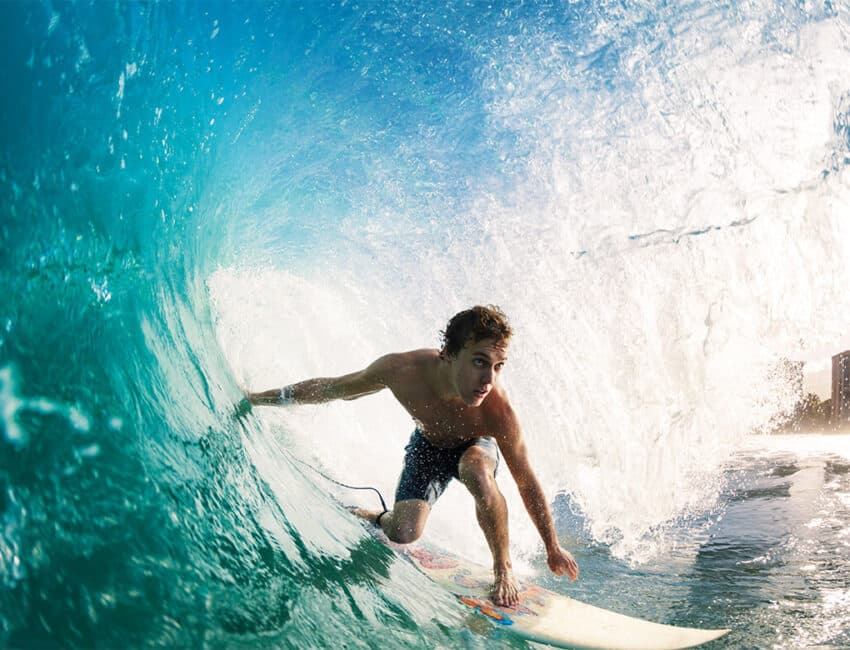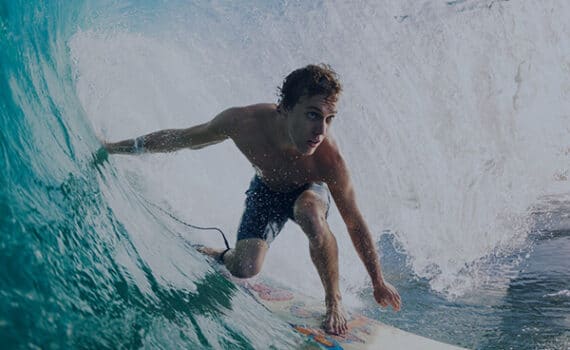North America’s East Coast boasts some of the most exciting and diverse surf spots that cater to surfers of all skill levels. Surfers can find unique challenges and thrilling experiences at each location – from the powerful breaks of Cape Hatteras to the gentle rollers along Florida’s coastline. These amazing surf spots on the east coast welcome both newcomers and seasoned wave riders throughout the year.
The region’s beach towns come alive with excellent surfing conditions shaped by seasonal weather patterns, including hurricane season and nor’easters. This piece highlights top destinations along the coastline, including famous breaks like New Smyrna Beach and the Outer Banks. You’ll find everything about beginner-friendly locations, challenging spots for advanced surfers, and practical tips to make the most of East Coast waves.
Beginner-Friendly of the Best Surf Spots on the East Coast
The East Coast has several perfect spots where beginners can catch their first waves during their surfing trip. Gentle surf conditions paired with excellent facilities and professional instruction make these locations ideal for new surfers.
Cocoa Beach, Florida
The Surf Capital of the East Coast, Cocoa Beach stands as a prime spot where novice surfers can learn the sport. This iconic beach is Kelly Slater’s hometown and features consistent, gentle waves that make learning easier. The area’s surf schools and training centers, including Florida’s largest surfing institution – Ron Jon Surf School, help beginners master the basics. The beach’s sandy bottom and clear waters create a perfect environment where new surfers can build their confidence.
St. Augustine Beach, Florida
St. Augustine Beach lifts the beginner surfing experience with its easily available waves. The beach maintains a consistent wave pattern that helps newcomers and provides enough variety for progression. This location stands out because of its:
- Year-round suitable conditions for learning
- Wide beaches with plenty of space to practice
- Multiple surf zones for different skill levels
- Clear visibility and manageable wave heights
Wrightsville Beach, North Carolina
Wrightsville Beach welcomes new surfers with open arms, especially when you have warm weather. This beach’s surfing heritage spans almost 100 years, and newcomers still flock to its friendly shores. The summer brings perfect conditions with comfortable water temperatures and gentle waves that new surfers love.
The beach gives newcomers several ways to start surfing:
- Private one-on-one instruction
- Small group lessons
- Full-day surf camps with experienced instructors
Wrightsville’s layout has multiple beginner-friendly spots. Access #4 stands out as a favorite spot because of its spacious parking and clean bathroom facilities. Surfers who show up before 9 AM catch the best waves without crowds and save money on parking.
These spots blend gentle waves, expert instruction, and great facilities that help make surfing fun and safe. New surfers will love starting their surf adventures here, whether they’re drawn to Florida’s warm waters or North Carolina’s friendly vibes.
Intermediate-Level Surf Destinations
Want to take your surfing to the next level? These surf spots blend the perfect mix of challenge and thrill that will help you become a better surfer.
Folly Beach, South Carolina
Located just 20 minutes from Charleston, Folly Beach is known as South Carolina’s premier surf destination. The area’s crown jewel, “The Washout,” produces powerful rolling surf that coastal positioning uniquely shapes. This special spot becomes even more remarkable during storm swells when it creates excellent waves that encourage intermediate surfers to test their skills.
Key features that make Folly Beach stand out:
- Consistent wave patterns during hurricane season
- Multiple jetty-created peaks along the coastline
- Strong local surf community
- Excellent wave quality during northeastern swells
Cisco Beach, Nantucket, Massachusetts
Surf enthusiasts will find Cisco Beach a unique East Coast destination that captures New England’s surf culture. The beach stands out with its crystalline waters and impressive swells that challenge intermediate surfers and help them improve their skills. This “rough side” of the island creates perfect conditions for surfers ready to take on more powerful waves.
The beach comes equipped with everything you need:
- On-site surf equipment rentals
- Professional lifeguard coverage
- Ample parking facilities
- Local surf school access
Kitty Hawk, Outer Banks, North Carolina
Kitty Hawk lies in the heart of the Outer Banks and serves as proof of East Coast surfing excellence. Its unique geographical position creates some of the most dependable surf conditions along the coast. Powerful waves emerge during post-storm periods, giving intermediate surfers exactly what they dream about.
Summer and early fall bring remarkable consistency to Kitty Hawk’s waves. Surfers love this spot because it combines accessibility with quality waves. The location boasts excellent facilities with easy parking access, and surfers can find many surf shops and rental options nearby.
Each season shapes the waves differently at Kitty Hawk. Summer delivers clean, consistent sets that help surfers perfect their technique. The approach of tropical systems turns this spot into a wave-riding paradise. These challenging conditions push intermediate surfers to advance their skills.
Advanced Surfer Hotspots
The Atlantic seaboard’s advanced spots offer unique surfing experiences with challenging waves and powerful swells that skilled riders seek.
Ruggles, Newport, Rhode Island
Ruggles sits in America’s smallest state and serves as proof of East Coast surfing prowess. Advanced surfers consider this legendary spot the go-to location for the biggest hurricane surf on the East Coast. The break creates ledging right-handers that peak during solid south-to-southeast swells.
Essential Features:
- Large-to-big wave experience required
- September through March brings the best conditions
- Serious swells demand semi-gun or full gun boards
- Clean water and street parking available
Low tide produces the best waves, and conditions peak as southeast swells mix with northwest offshore winds. Advanced surfers get the most consistent clean waves during winter months, with February delivering the best results.
Cape Hatteras, North Carolina
The pinnacle of East Coast surfing lies at Cape Hatteras, especially at its iconic Lighthouse Beach. This remarkable spot brings together nor’easter pressure systems from the north and tropical swells from the south. The lighthouse’s area became a landmark for one of the coast’s most dynamic surf zones after relocating from its original position in 1999.
Wave Characteristics:
- Mixed groundswells and windswells
- Ideal south swell direction
- Beach breaks offering both lefts and rights
- All-tide performance capability
Surfers can find consistent waves throughout the year, and February provides the highest percentage of clean, rideable waves. The relatively uncrowded lineup attracts advanced surfers who need to stay alert for rips and occasional shark activity.
New Smyrna Beach, Florida
New Smyrna Beach stands out as the Atlantic coast’s most consistent wave spot with reliable surf conditions throughout the year. Professional surfers like Lisa Anderson, Kelly Slater, and Evan Geiselman have used this location as their training ground, cementing its status as a surfing hub.
What Makes It Special:
- Long beaches with premium sandbars
- Works with any tide and swell direction
- Regular surf competition venue
- Waves that just need advanced skills
Hurricane season brings out this spot’s true potential, and fall sessions create epic surfing conditions. Advanced surfers often discover surprisingly powerful waves here, even when least expected. The spot draws crowds during prime conditions, but multiple peaks give surfers plenty of space in the lineup.
Advanced surfers should remember that New Smyrna’s gear requirements change with seasons, despite Florida’s warm climate. Surfers typically use spring suits or wetsuit tops in late fall. Winter brings colder conditions that might call for a 3/2 full wetsuit and sometimes even booties.
Tips for Surfing on the East Coast
Surfers who want to become skilled at riding Atlantic seaboard waves must understand their unique characteristics and get ready. The complete guide to conquering East Coast waves covers everything from seasonal patterns to the right gear.
Best seasons for surfing
The East Coast’s surf calendar naturally splits into distinct periods that create different wave conditions. Fall emerges as the prime surfing season, and hurricane swells generate some of the year’s best waves. Powerful storms in the Atlantic Ocean create ideal surfing conditions from Florida to Maine.
Winter brings consistent swells through nor’easters, and temperatures can drop into the minus teens. These cold-weather sessions deliver the most powerful waves along the northern coastline. Surfers find the most consistent conditions in spring, while summer waves are smaller and more manageable for skill development.
Wave quality on the East Coast changes by a lot based on weather patterns:
- Fall (September-November): Hurricane swells create optimal conditions
- Winter (December-February): Nor’easters generate powerful waves
- Spring (March-May): Consistent, moderate conditions
- Summer (June-August): Smaller waves, ideal for practice
Essential gear for East Coast surfing
East Coast surfing just needs specific equipment to handle varying conditions. Here’s the essential gear checklist for East Coast surfers:
- Primary Equipment:
- Surfboard appropriate for skill level
- High-quality leash
- Surf wax or traction pad
- Wetsuit (2mm to 4/3mm depending on season)
- Rash guard for sun protection
- Additional Protection:
- Surf earplugs for cold water
- Waterproof surf camera
- Boots and gloves for winter sessions
- Wet/dry bag for gear transport
Soft-top surfboards give beginners the ideal learning platform. These boards provide better stability and help you learn with fewer falls. You can switch to fiberglass boards to boost your performance once your skills improve.
Safety considerations
Safety comes first when surfing the ever-changing waters of the East Coast. Wave heights range from 2 to 6 feet, and swells can reach 8 to 10 feet during peak seasons. Safe surfing depends on your understanding of these conditions.
Essential Safety Tips:
- Check weather and surf forecasts before sessions
- Understand local tide patterns and their effects
- Identify potential risks like rocks or reefs
- Stay aware of rip currents and their locations
- Maintain proper distance from other surfers
Marine life awareness is a vital part of East Coast surfing safety. Surfers need to watch out for:
- Shark activity in certain areas
- Presence of jellyfish
- Stingray populations
- Other local marine hazards
Weather patterns substantially affect surf conditions. Offshore winds create clean, well-formed waves that are perfect for surfing. Surfers must keep track of:
- Wind direction and speed
- Incoming storm systems
- Swell direction and size
- Local weather advisories
The East Coast sees weather systems that shape surf quality. Hurricane season runs from June to November and can create massive swells. Winter months bring powerful waves from nor’easters. These conditions need extra caution and proper preparation.
Surfers should follow these guidelines to stay safe:
- Choose guarded beaches if possible
- Watch for warning flags and signs
- Observe waves for 15 minutes before entering
- Never surf alone in challenging conditions
Wave formation knowledge helps predict conditions better. Beach breaks are common along the East Coast. They create waves that break over sandy bottoms within 100 yards of shore. These conditions change faster, so surfers must stay alert and adapt quickly.
Conclusion
The East Coast’s surfing scene shows evidence of nature’s diversity with waves that suit every skill level along its expansive coastline. Cocoa Beach offers gentle rollers that beginners love, while Cape Hatteras challenges advanced riders with powerful breaks. Each spot features unique characteristics that seasonal patterns and local geography shape. The weather patterns change throughout the year and create an array of surfing opportunities that match any coastal destination.
East Coast’s best waves need careful preparation, proper gear, and safety awareness. Wave riders who know their local conditions and respect weather patterns will find remarkable waves year-round. The Atlantic seaboard’s vibrant surf culture draws people to its shores with professional instruction, great facilities, and friendly communities. These elements create authentic coastal experiences that keep surfers coming back.
References
[1] – https://happyswatersports.com/blog/a-beginners-guide-to-surfing-in-florida/
[2] – https://www.visitspacecoast.com/blog/learn-to-surf-in-cocoa-beach/
[3] – https://salty-home.com/blogs/salty-stories/surf-spots-atlantic-coast-usa?srsltid=AfmBOoqHs03b2G19nRF_Ouqk4k7pWjSBwuJXJukH9T8l_yTghtJJxoc7
[4] – https://www.wrightsvillebeach.com/wrightsville-beach-surfing-guide.html
[5] – https://wrightsville-beach.wilmingtonandbeaches.com/blog/post/drop-in-on-these-five-secret-wrightsville-beach-surf-spots/
[6] – https://blog.wetsuitwearhouse.com/best-east-coast-surfing-spots/
[7] – https://salty-home.com/blogs/salty-stories/surf-spots-atlantic-coast-usa?srsltid=AfmBOoqx7xZ0RP8G9FyJODNXEClf4g77aqkBMR4V43yszLm4B12nWswc
[8] – https://www.outerbanks.org/things-to-do/water-activities/water-sports/surfing/
[9] – https://www.surfline.com/surf-report/ruggles-newport/5842041f4e65fad6a77089ce/spot-guide
[10] – https://www.surf-forecast.com/breaks/Ruggles
[11] – https://thesurfatlas.com/surfing-in-the-usa/surfing-on-the-east-coast/
[12] – https://salty-home.com/blogs/salty-stories/surf-spots-atlantic-coast-usa?srsltid=AfmBOorwTvy63ajAaX8cOp1FMLO4q5_VQxWxaS9nPqJ2SPZWLRU0R6aC
[13] – https://www.surf-forecast.com/breaks/Frisco-Pier
[14] – https://www.americansurfmagazine.com/article/new-smryna-beach-surfing
[15] – https://www.mywavefinder.com/destination/new-smyrna-beach-florida-surf-guide/
[16] – https://flipphead.com/2024/05/29/surfing-the-easy-coast/?srsltid=AfmBOoptwE0UhbzHVNkjTktDe7ylRF2VgUUEaKvH81yk_8hMftBSrljZ
[17] – https://www.surferdad.co.uk/surfing-cold-east-coast-england
[18] – https://www.outerbanksblue.com/blog/surfing-on-the-outer-banks-a-breakdown-by-seasons
[19] – https://www.surfertoday.com/surfing/the-surfing-equipment-list
[20] – https://www.theinertia.com/gear/beginning-surfer-gear-essentials/
[21] – https://www.northeastsurfing.com/education/reading-forecast-reports/


